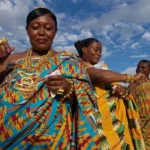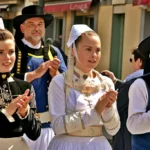Ethiopia, one of the oldest nations in the world, is renowned for its vibrant culture, deep history, and diverse traditions. Among its many cultural treasures, traditional clothing holds a special place as a symbol of identity, spirituality, and artistry. Rooted in centuries-old customs, Ethiopian attire reflects the country’s diverse ethnic groups, geography, and rich heritage.
This article explores the traditional clothing of Ethiopia, examining its historical significance, regional variations, and continued relevance in modern times.
The Foundation of Ethiopian Traditional Attire
Ethiopian traditional clothing is intricately tied to the country’s history, religion, and cultural diversity. The garments often feature natural fibers, handwoven techniques, and exquisite patterns that showcase the craftsmanship of Ethiopian artisans.
The most iconic traditional fabric is “shemma”, a lightweight, handwoven cotton material commonly used for garments across various regions. Worn by men and women, shemma is typically adorned with colorful borders known as “tibeb”, which vary in complexity and design depending on the wearer’s status, occasion, or cultural group.
See also Traditional Clothing in Ghana: A Vibrant Expression of Culture and Identity
Traditional Clothing in Ghana: A Vibrant Expression of Culture and IdentityKey Elements of Ethiopian Traditional Clothing
Habesha Kemis
The Habesha Kemis is the quintessential traditional dress for Ethiopian women, especially among the Habesha ethnic group.
- 🌸 Design: The dress is made of white or beige shemma fabric and features elaborate tibeb patterns along the edges. These patterns are often hand-embroidered and incorporate vibrant colors like gold, green, and red.
- Cultural Significance: The Habesha Kemis is worn during religious ceremonies, weddings, and festivals, symbolizing elegance and cultural pride.
Netela and Gabi
- 🧣 Netela: A lightweight cotton shawl, the netela is a staple for Ethiopian women, often draped over the shoulders or head. It is an essential accessory for church services and formal occasions.
- 🧥 Gabi: A thicker version of the netela, the gabi is worn by men for warmth or as a mark of respect during traditional ceremonies.
Kemis for Men
Men’s traditional attire includes a long white tunic or shirt paired with loose-fitting pants. These garments are often accompanied by a shemma shawl draped over the shoulder, adding a formal touch to the ensemble.
Jewelry and Accessories
Ethiopian women often complement their attire with traditional jewelry made of silver, gold, or beads. These accessories include:
- Necklaces and Pendants: Often featuring religious symbols such as the Ethiopian Orthodox cross.
- Hair Accessories: Women adorn their braided hairstyles with beads and ornaments, enhancing their overall appearance.
Regional Variations in Ethiopian Traditional Clothing
Ethiopia’s diverse ethnic groups have distinct clothing styles that reflect their unique traditions, environment, and cultural practices.
See also Traditional clothing in Saint Pierre and Miquelon
Traditional clothing in Saint Pierre and MiquelonAmhara and Tigray
- Elegant and Detailed: Both regions are known for their intricate tibeb patterns on shemma garments. Women wear the Habesha Kemis with brightly colored borders, while men don traditional tunics and shawls.
- Religious Influence: The Ethiopian Orthodox Church plays a significant role in shaping clothing styles, emphasizing modesty and the use of netela.
Oromo
- Bold Colors and Patterns: The Oromo people wear brightly colored attire, often made from handwoven cotton. Women’s dresses are adorned with beadwork, while men wear embroidered tunics and shawls.
- Cultural Symbols: Jewelry and accessories frequently feature symbols of nature, reflecting the Oromo people’s strong connection to the land.
Somali
- Flowing Garments: The Somali ethnic group in Ethiopia favors loose-fitting robes and scarves, often made from lightweight materials suited to the arid climate.
- Vibrant Scarves: Women wear colorful hijabs or shawls, adding a touch of elegance to their attire.
Southern Tribes (e.g., Hamar, Mursi)
- Leather and Beads: In the Omo Valley, tribal groups like the Hamar and Mursi wear garments made of leather, adorned with beads and cowrie shells.
- Symbolic Decorations: Body painting and intricate hairstyles are integral to traditional attire, particularly during ceremonies and rituals.
Traditional Clothing in Religious and Cultural Celebrations
Ethiopian traditional clothing plays a central role in religious and cultural festivals, showcasing the country’s rich heritage.
Timket (Epiphany)
During this Christian festival, celebrants wear their finest traditional attire, including white Habesha Kemis and shawls. Priests don ornate robes and carry embroidered umbrellas, adding a regal touch to the ceremonies.
Weddings
Traditional Ethiopian weddings are a vibrant display of cultural attire. Brides often wear elaborately designed Habesha Kemis, while grooms don white tunics with matching shawls. The outfits symbolize purity, unity, and respect for tradition.
Coffee Ceremonies
The Ethiopian coffee ceremony, a cornerstone of the country’s social life, sees participants dressed in traditional attire. Women hosting the ceremony often wear tibeb-adorned dresses, emphasizing hospitality and elegance.
The Modern Revival of Ethiopian Traditional Clothing
In recent years, Ethiopian traditional clothing has experienced a resurgence in popularity, both within the country and among the diaspora.
Fashion and Innovation
Contemporary designers like Feiruza Mudessir and Abai Schulze are reimagining traditional attire by incorporating modern cuts and fabrics while preserving the essence of Ethiopian culture. Their designs are celebrated on global runways, blending tradition with innovation.
Cultural Pride
Ethiopians proudly wear traditional clothing during national holidays, festivals, and international events, showcasing their heritage on the world stage.
Why Ethiopian Traditional Clothing Matters
Ethiopian traditional clothing is more than just fabric and design—it is a symbol of cultural identity, resilience, and artistic expression. Each garment tells a story, connecting the wearer to their history, community, and spirituality. As Ethiopia continues to celebrate its heritage, traditional clothing remains a testament to the country’s rich cultural legacy.
